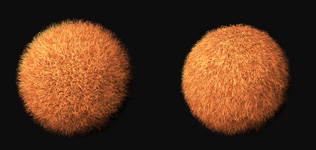Making Grass and Fur Move

Autor: Sven Banisch
Betreuer: Prof. Dr. Charles A. Wüthrich
This thesis introduces physical laws into the real time animation of fur and grass. The main
idea to achieve this, is to combine shellbased rendering and massspring systems.
In a preprocessing step, a volume array is filled with the structure of fur and grass by a
method based on exponential functions. The volumetric data is used to generate a series of
two dimensional, semitransparent textures that encode the presence of hair. In order to
render the fur volume in real time, these shell textures are applied to a series of layers
extruded above the initial surface.
Moving fur can be achieved by laterally displacing these shell layers at runtime. The usage of a
massspring system to determine this displacement has not yet been tried, mainly, they have
been used for the interactive simulation of the dynamical behavior of cloth, or long hair.
This thesis shows that massspring systems also form an applicable physical model to simulate
the dynamics of fur and grass.
For the simulation of a massspring system, two numerical solvers are implemented. The first
one is based on explicit Euler integration, and the second one is derived from an implicit Euler
scheme. This thesis outlines the effects of different numerical solvers on performance and
stability.
In order to simulate fur and grass dynamics, different ways of generating masses and springs
over the surface are discussed. Six so called massspring topologies are introduced and
used in animation. Three of them allow that the shell layers separate laterally, and the parting
of grass can be simulated. Performance observations prove massspring systems to be
wellsuited for the real time simulation of fur and grass dynamics.
Material:
